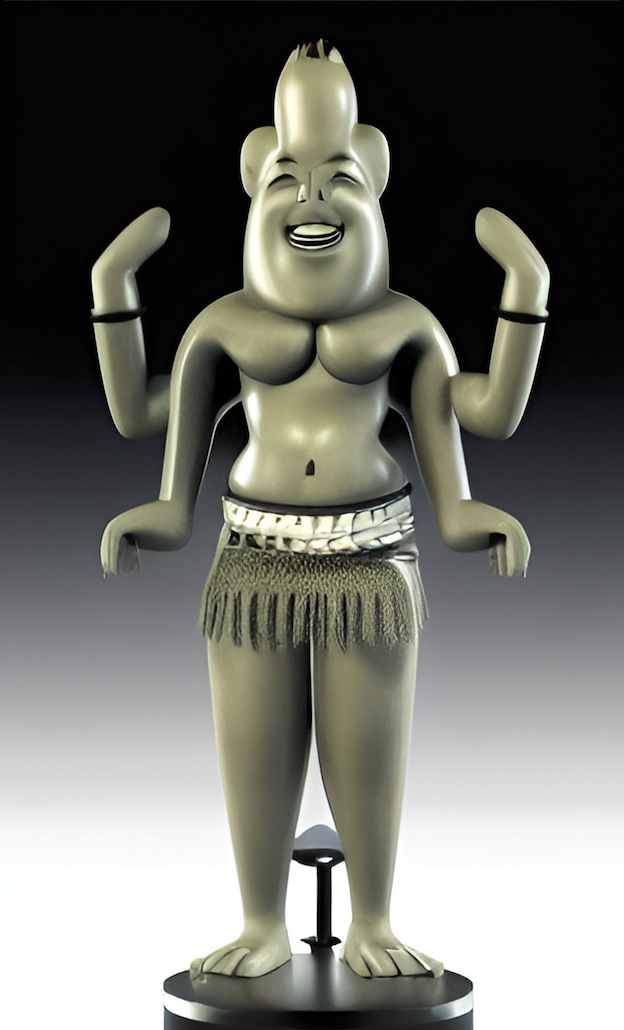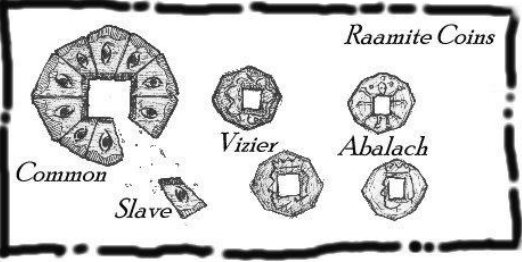The mansabdars are Raam’s police, city watch,
and soldiers. They are a mundane part of the civil
administration, supervised as needed by the templars.
Their main duty is to enforce the Grand Vizier’s laws,
but their ranks teem with corruption. Most mansabdars
are on the payroll of warlords or wealthy merchants and
spend their time watching out for their patrons’ interests.
Other mansabdars shake down commoners and artisans in
their districts, work for criminal gangs, or arrest whomever
they’re paid to arrest.
Given the malfeasance of the mansabdars and the
breakdown of templar authority, Abalach-Re relies more
and more on the kuotagha – an organization of secret
police – to enforce her will. Like the mansabdars, they are
an arm of the civic government, loosely overseen by the
templars. Little better than assassins, the kuotagha hide
among the populace, striking without warning to eliminate
undesirables.
“Raam is a city exhausted. The land can support it no longer. There are no treasures left to pluck from the earth. The sorcerer-queen? She hides, knowing death waits in every shadow. The warlords? Petty, feckless, and brutal. Don’t waste your water on us.”
- Gaurav, disaffected rebel
Population: 40,000 (40% human, 20% dwarf, 10% mul, 15% elf, 5% half-elf, 5% half-giant, 4% thri-kreen, 1% halfling; 5% priests, 10% templars and soldiers, 20% merchants, artisans, and landowners, 60% servants and laborers, 5% untouchable).
Natives are called “Raamites” or “Raamish.”
Emblems: Abalach-Re’s face; Badna, a four-armed man in a long loincloth. Abalach-Re devised Badna, the “greater power,” to justify her authority.
Economy: Silver, gems, flint; jute, a fibrous plant; silk; carpets, textiles, art.

Ancient and magnificent, Raam has fallen far from its formerly wondrous heights. Centuries of plundering the countryside for its resources, rampant corruption in its government, and the rule of a hedonistic and disinterested sorcerer-queen have brought the city-state to the brink of disintegration. The alabaster quarries and gemstone mines stand exhausted; reckless agricultural practices have led to disastrous food shortages. In the streets, violent factions sworn to one warlord or another battle for control as the once-vibrant and influential city slips into ruin. Mobs riot daily against their ineffectual ruler, the sorcerer-queen Abalach-Re, and her templars dare not set foot in some of the city’s districts. The present difficulties might have been averted by a strong hand, but Abalach-Re had less interest in ruling than in feeding her insatiable appetite for pleasure. Generations ago, she abandoned her royal title and declared herself to be the representative of an all-powerful deity known as Badna.
 Calling herself the Grand Vizier,
a title normally held by Raam’s greatest mystics, she razed
the city’s existing shrines and temples, replacing them with
new shrines dedicated to Badna. The deity’s image – that
of a grinning, four-armed male dressed in a long loincloth
– appears all over the city-state. Abalach-Re continues to
assure the citizens that Badna watches her closely and
will strike her dead if she falters in her duties, but few
believe her anymore.
Calling herself the Grand Vizier,
a title normally held by Raam’s greatest mystics, she razed
the city’s existing shrines and temples, replacing them with
new shrines dedicated to Badna. The deity’s image – that
of a grinning, four-armed male dressed in a long loincloth
– appears all over the city-state. Abalach-Re continues to
assure the citizens that Badna watches her closely and
will strike her dead if she falters in her duties, but few
believe her anymore.
More than 40,000 people live in Raam, making it the
most populous of the city-states. Another 40,000 or so
dwell in the warlord-dominated estates surrounding the
city. Humans constitute less than half the population.
Elves and dwarves are the most numerous minorities, and
muls, half-giants, and half-elves make up most of the rest.
Raam draws water from a deep reservoir below the
city, which provides enough to sustain the populace and
irrigate the fields beyond.
Although the renowned mines have been picked clean
and the current troubles have all but paralyzed trade,
Raam retains enough commodities to lure merchants. The
city exports silver, gemstones, flint, silk, rugs, art, and
textiles, among other goods.
The mansabdars form the heart of the largest army
in the Tyr Region, leading thousands of wretched slave
soldiers. In addition, Abalach-Re hoards weapons, armor,
and equipment in an enormous armory beneath her
palace.


